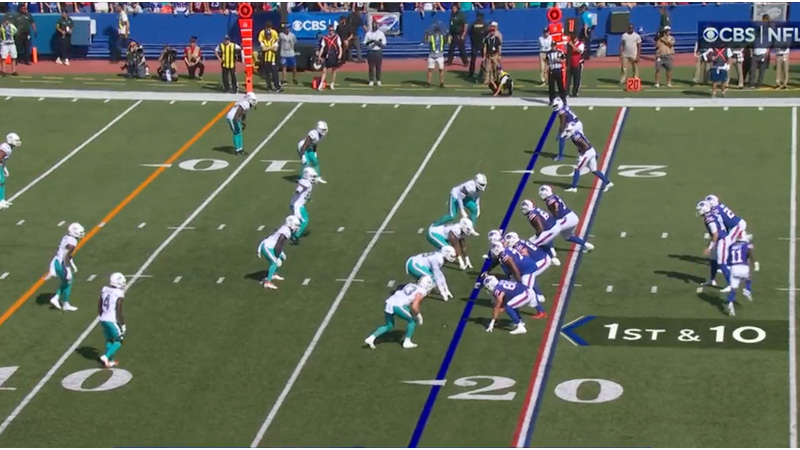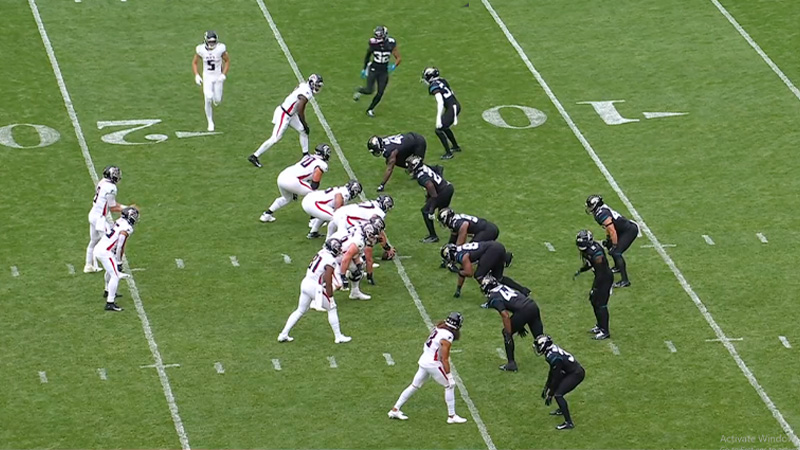Football, an intricate dance of strategy and athleticism, is defined by the points on the scoreboard. From the exhilaration of touchdowns to the precision of field goals, the scoring system adds layers of drama to each game.
In this exploration of “How Does Scoring Work In Football,” we’ll unravel the mechanisms behind touchdowns, extra points, field goals, safeties, and the elusive two-point conversion.
Delving into the rules and nuances, we aim to demystify the scoring system that shapes the ebb and flow of every match.
Whether you’re a seasoned fan or a newcomer to the gridiron, understanding football’s scoring intricacies enhances the appreciation of this quintessential American sport.
The Basics of Scoring In American Football
American football is a complex game with detailed rules and scoring systems. Here are the basics of scoring in American football:
Touchdown (6 points)
The primary way to score is by scoring a touchdown. This occurs when a player carries the ball across the opponent’s goal line or catches a pass in the end zone. It’s worth six points.
Extra Point (1 or 2 points)
After a touchdown, the scoring team has the option to attempt an extra point. This is a short kick (worth 1 point) or a play from the 2-yard line (worth 2 points).
Field Goal (3 points)
A team can score by kicking the ball through the opponent’s goalposts from anywhere on the field during a play. This is called a field goal and is worth 3 points.
Safety (2 points)
If the defensive team tackles an offensive player with the ball in their own end zone, the defense scores a safety, worth 2 points. The team that was tackled then has to kick the ball to the other team.
Two-Point Conversion (2 points)
Instead of attempting an extra point kick after a touchdown, a team can choose to run or pass the ball into the end zone from the 2-yard line. If successful, it’s worth 2 points.
Scoring Summary
- Touchdown: 6 points
- Extra Point (kick): 1 point
- Extra Point (run/pass): 2 points
- Field Goal: 3 points
- Safety: 2 points
- Two-Point Conversion: 2 points
Turnovers and Defensive Scores
If the defense intercepts a pass or recovers a fumble and returns it for a touchdown, or if they score a safety, they also get points for their team.
Overtime
In the case of a tie at the end of regulation, the game may go into overtime. Each team gets a chance to possess the ball from a predetermined spot on the field, and the team with the most points at the end of this period wins.
If the first possession results in a touchdown, the other team gets a chance to match it.
If the team with the first possession scores a field goal, the other team has a chance to either tie with a field goal or win with a touchdown.
These are the basic ways a team can score in American football. The game involves intricate strategies, and scoring often comes from a combination of well-executed plays, teamwork, and individual skill.
Methods of Scoring

In American football, teams can score points through various methods. Here are the primary methods of scoring:
- Touchdown (6 points): The most significant scoring play, a touchdown occurs when a player carries the ball across the opponent’s goal line or catches a pass in the end zone.
- Extra Point (1 or 2 points): After a touchdown, the scoring team has the option to attempt an extra point. This can be done by kicking the ball through the goalposts (worth 1 point) or by running or passing the ball into the end zone from the 2-yard line (worth 2 points).
- Field Goal (3 points): A field goal is scored by kicking the ball through the opponent’s goalposts during a play. Teams often attempt field goals on fourth down if they are within range and don’t want to risk turning the ball over.
- Safety (2 points): When the defensive team tackles an offensive player with the ball in their own end zone, it results in a safety, earning the defensive team 2 points. After a safety, the team that was tackled has to kick the ball to the other team.
- Two-Point Conversion (2 points): Instead of attempting an extra point kick after a touchdown, a team can choose to run or pass the ball into the end zone from the 2-yard line. If successful, it adds 2 points to the team’s score.
- Defensive Touchdown (6 points): If the defense intercepts a pass or recovers a fumble and returns it to the end zone, they score a defensive touchdown, worth 6 points.
- Overtime Touchdown and Two-Point Conversion (6 points): In overtime, if a team scores a touchdown, they have the opportunity to attempt a two-point conversion for an additional 2 points.
Different Scoring Situations in American Football

These scoring methods contribute to the overall dynamics of the game, creating a mix of offensive and defensive strategies. Teams aim to maximize their points while minimizing their opponent’s scoring opportunities.
Scoring in American football can occur in various situations, reflecting the dynamic nature of the game. Here are different scoring situations:
Regular Game Play
- Touchdown (6 points): When a player carries the ball across the opponent’s goal line or catches a pass in the end zone.
- Field Goal (3 points): Scored by kicking the ball through the opponent’s goalposts from anywhere on the field during a play.
- Safety (2 points): This occurs when the defensive team tackles an offensive player with the ball in their own end zone.
After a Touchdown
- Extra Point (1 point): Kicking the ball through the goalposts after a touchdown.
- Two-Point Conversion (2 points): Running or passing the ball into the end zone from the 2-yard line after a touchdown.
Defensive Scoring Plays
- Defensive Touchdown (6 points): If the defense intercepts a pass or recovers a fumble and returns it for a touchdown.
- Safety (2 points): The defensive team tackles an offensive player with the ball in their own end zone.
Overtime Scoring
- Overtime Touchdown (6 points): In overtime, if a team scores a touchdown, they may have the opportunity to win the game.
- Overtime Two-Point Conversion (2 points): After an overtime touchdown, the team has the option to attempt a two-point conversion for additional points.
Special Teams Plays
- Kickoff Return Touchdown (6 points): If a player returns a kickoff all the way to the end zone.
- Punt Return Touchdown (6 points): Similar to a kickoff return, but occurring after a punt.
Missed Field Goal Return
If a field goal attempt falls short, the opposing team can catch the ball and return it. If they reach the opposing end zone, they score a touchdown.
Situational Scenarios
- Two-Minute Drill: Teams may score in a hurry-up offense situation to maximize points before the end of the half or the game.
- Goal-Line Stand: Defenses can prevent an offensive team from scoring in short-yardage situations near the goal line.
Understanding these different scoring situations adds depth to the strategy and excitement of American football games. The combination of offensive, defensive, and special teams plays contributes to the complexity of the sport.
Penalty Shootouts in Scoring
Penalty shootouts are not a part of scoring in American football. Penalty shootouts are a common tiebreaker in sports like soccer (football in most parts of the world), where a match must have a clear winner, and the game cannot end in a tie.
American football, however, has a different approach to resolving ties.In the regular season of the National Football League (NFL), for example, if a game is tied after the regulation time (four quarters of 15 minutes each), the game can end in a tie.
In playoff games, there are overtime rules that allow for additional periods to be played until there is a winner. Each team gets an opportunity to possess the ball, and the game continues until one team has more points at the end of an overtime period.
The concept of penalty shootouts, as seen in soccer, is not used in American football. The overtime rules are designed to provide each team with a fair chance to win the game through regular gameplay, rather than a specific set of penalty kicks.
The idea is to maintain the fundamental aspects of American football, including offense, defense, and strategic decision-making, in determining the winner of a game.
FAQs
How are touchdowns scored in football?
Touchdowns are scored when a player carries the ball across the opponent’s goal line or catches a pass in the end zone. A touchdown is worth six points, and it’s the most significant scoring play in football.
What is an extra point in football?
An extra point is a scoring attempt after a touchdown. It can be a short kick through the goalposts (1 point) or a play from the 2-yard line (2 points), providing teams with options to extend their lead.
How do field goals contribute to scoring?
Field goals are worth three points and are scored by successfully kicking the ball through the opponent’s goalposts from anywhere on the field during a play. Teams often attempt field goals on fourth down.
What is safety and how does it impact scoring?
A safety is scored when the defensive team tackles an offensive player with the ball in their own end zone. It awards the defensive team two points, and the team that was tackled has to kick the ball to the opposing team.
When does a two-point conversion happen?
A two-point conversion occurs after a touchdown instead of the traditional extra-point kick. The scoring team has the option to run or pass the ball into the end zone from the 2-yard line, earning them two additional points.
Wrapping Up
In the symphony of tackles, passes, and runs, football’s scoring system orchestrates the narrative. Touchdowns electrify stadiums, field goals alter momentum, and safeties inject surprise.
The dance between offense and defense, marked by extra points and two-point conversions, defines victories.
As we close the playbook on “How Does Scoring Work In Football,” we recognize that each point earned is a chapter in the unfolding drama.
Whether cheering for your favorite team or witnessing the game’s beauty for the first time, comprehending scoring nuances enriches the experience, making football not just a sport but a captivating spectacle of strategy and skill.







